US Tax Payer Bail-out Ideas Stabilize US Dollar, Sovereign Wealth Funds to the Rescue?
Interest-Rates / Credit Crisis 2008 Apr 04, 2008 - 09:36 PM GMTBy: Gary_Dorsch

 It was “April Fools” day, and Wall Street was busy spinning bad financial news into bouts of irrational exuberance. News of a $19 billion write-down of toxic sub-prime mortgage debt at Swiss bank UBS and a $4 billion hit at Deutsche Bank might have sparked a panic sell-off in global stock markets a few weeks ago. But on “April Fools” day, the Dow Jones Industrials soared 391-points, and the broader S&P 500 Index jumped 3.6%, posting its best 2nd-quarter start since 1938.
It was “April Fools” day, and Wall Street was busy spinning bad financial news into bouts of irrational exuberance. News of a $19 billion write-down of toxic sub-prime mortgage debt at Swiss bank UBS and a $4 billion hit at Deutsche Bank might have sparked a panic sell-off in global stock markets a few weeks ago. But on “April Fools” day, the Dow Jones Industrials soared 391-points, and the broader S&P 500 Index jumped 3.6%, posting its best 2nd-quarter start since 1938.
Shares of UBS soared 18%, after the Swiss bank said it could plug the craters in its balance sheet with a $15 billion rights offering, led by a syndicate of JP Morgan, Morgan Stanley, BNP Paribas and Goldman Sachs. Shares of Lehman Bros jumped 22% after it raised $4 billion from the sale of convertible preferred shares, and squeezing bearish speculators in LEH puts in the process.
Before the “April Fools” day festivities, the S&P 500 Index had posted five straight months of losses, and a 10% slide in the first quarter. In its infinite wisdom, the stock market has already discounted a recession, which probably arrived in the first quarter. Earnings for S&P 500 companies are expected -8.1% lower in Q'1 from a year ago, down from rosy projections of +4.7% at the beginning of the quarter.
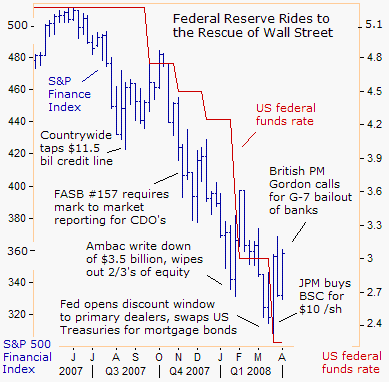
But the badly battered US financial sector soared 15% on “April Fools” day, after British PM Gordon Brown called on the Group of Seven central bankers, to stop worrying about “moral hazard” and start backing a joint plan to recapitalize global banks and buy-out the toxic sub-prime mortgages, to rescue the banking system. Of course, such a bailout initiative would be funded with taxpayer's money, with a small price of tougher regulation of the industry. “We have got to make these changes immediately,” Brown said on April 1st.
British PM Brown discussed his solutions for the global banking crisis with US President Bush at a NATO summit on April 3rd. “We were talking about major issues that we can collectively do about the world economy,” he told reporters. Brown is also talking with the leaders of Germany, France, “about how we can make changes that we need in the world economy, as quickly as possible.”
Goldman Sachs figures losses from toxic sub-prime mortgage debt at US banks could reach $460 billion, and only $120 billion have been recognized so far. Losses worldwide could hit $1.2 trillion. Such a meltdown could topple a few banks along the way, and unleash even more turmoil in global stock markets. So many traders are now betting that the G-7 central bankers and finance ministers will endorse a tax payer funded bailout for the banks, at their upcoming April 11th meeting.
The earliest hint of a G-7 bailout plan was first proposed by Japan's financial services minister Yoshimi Watanabe on March 24th. “It is essential for the US to understand that given Japan's lesson, public fund injection into the financial sector is unavoidable. We could convey this lesson at the G-7 central bank meeting, and we are prepared to take coordinated action, to help resolve the issue,” Watanabe said.

Is speculation of a US government led bailout to rescue the banking industry a realistic proposition, or just a nasty “April Fools” joke? Washington might be left little choice but to lead a taxpayer bailout for banks choking on toxic sub-prime mortgages, because a rising tide of home foreclosures could crush the US economy without such a plan.
There are hundreds of billions of dollars worth of home mortgages in arrears, in foreclosure or that homeowners have walked away from. US Treasury Secretary Henry Paulson now says he's flexible to new ideas of intervention.
Free market capitalism is out of favor in Washington, and in its place, government intervention is the norm of the day. Voters are demanding immediate help, especially after the Fed-engineered bailout of Bear Stearns and its massive financial assistance to other Wall Street dealers. The Bear Stearns bailout has opened the doors for US politicians facing re-election to call for bailouts of distressed homeowners.
There is a long history of US government bailouts. In the late 1980's and early 1990's, more than 1,000 savings and loan institutions failed, leading to a federal bailout totaling roughly $125 billion. In 1975, President Ford provided a struggling New York City with a $7 billion loan package. President Clinton came to Mexico's aid in 1995 after a sharp devaluation of the peso, with $50 billion of loans.
Congress bailed out Lockheed Aircraft in 1971 and Chrysler in 1979 with loan guarantees. In 1984, Continental Illinois was effectively taken over by the federal government. After the Sept 11th terror attacks, Congress authorized $5 billion in cash to help shore up the airline industry and $10 billion in loan guarantees. Most recently, the Bernanke Fed guaranteed $30 billion of toxic sub prime mortgage debt sitting in Bear Stearns, with taxpayer money.
Just how costly a US government bailout to purchase existing sub-prime mortgage loans is anyone's guess, but it's probably much cheaper than the cost of the FDIC paying off depositors of failed banks. It would certainly be much less than the $845 billion that Congress has already appropriated for military operations, reconstruction, embassy costs, and US bases and foreign aid programs in Iraq and Afghanistan.
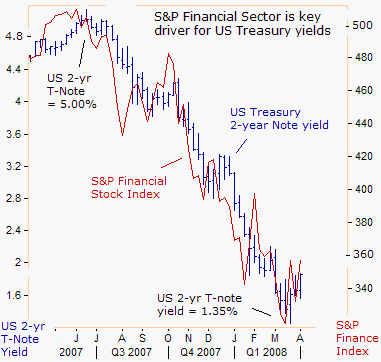
A massive US government bailout would add hundreds of billions to the outstanding supply of US Treasuries, but greatly relieve the stress in the banking system. It could unleash a rapid unwinding of “safe haven” positions in US 2-year T-notes, and lift US interest rates sharply higher. It could also trigger a reversal of the Fed's rate cuts since September and a tighter US money policy in the second half of 2008.
With the yield on the US Treasury's 2-year note jumping to 1.95% this week, from a record low of 1.35% two weeks ago, it's already narrowed the scope of a Fed rate cut in April to a quarter-point. In testimony on Capitol Hill on April 3rd, Fed chief Ben Bernanke said, “The effects of monetary of policy are felt over a period of time and we expect to see positive effects of these policies going forward.” Until then, Fed policy might stay on hold at 2% because, “there's a chance in the first half there might be a slight contraction,” Bernanke said.
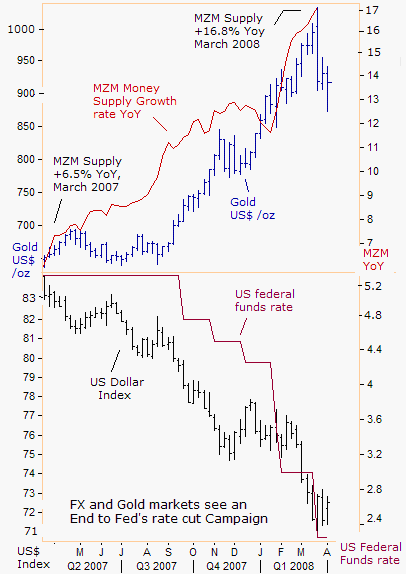
Expectations that the Fed's rate cutting campaign is nearing an end, has stabilized the US dollar, with the greenback's strongest gains seen against the Japanese yen, which offers negative rates of interest after adjusting for inflation, and the British pound, in anticipation of gradual rate cuts by the Bank of England. The Bank of Canada is expected to match any residual Fed rate cut in this cycle.
The Gold market was rattled after its historic rally fizzled out above the psychological $1,000 /oz level, and surprising moves by the Federal Reserve to drain some excess cash out of the US banking system, after the rescue of Bear Stearns. But Mr Bernanke and his radical band of inflationists at the Fed, have expanded the MZM money supply by 16.8% from a year ago, which could ignite hyper-inflation in the US economy, once the monetary stimulus in the pipeline starts to take effect.
Crude oil remains perched above the once unthinkable $100 /barrel level, as global demand should outstrip supply later this year, and as global investors seek a hedge against the Fed's cheap money policies. If a G-7 government led bailout of the banks should fail to materialize, the Fed's won't be able to rescue the dollar with higher rates, and sentiment in the gold market could turn bullish again.
Direction of Fed policy moving Japanese yen /US$
It's the direction of US Treasury yields and the S&P financial sector, that's having a big influence over the direction of the US dollar these days. The Japanese yen /US$ exchange rate is tracking the interest rate differential between the US Treasury's 2-year note and the comparable Japanese 2-year note. So far this year, the dollar's interest rate advantage has shrunk to +132 basis points from +250 bp, which in turn, has knocked the dollar from 114-yen to around 102.50-yen today.
The dollar briefly fell to 96-yen, it's lowest level in 13-years, when the interest rate spread plunged to as low as +75 basis points. Despite the dollar's sharp slide under 100-yen and the resulting havoc in the Nikkei-225 stock index, the Bank of Japan was under no pressure from Tokyo to ease its monetary policy. Kaoru Yosano, a heavyweight in the ruling Liberal Democratic Party, said, “With short-term interest rates being 0.5%, there is no room to cut rates, and therefore it does not make much sense to do so,” taking the political heat off the BoJ.

Thus, the dollar /yen's gyrations have mostly focused on the direction of volatile US Treasury yields. Amid sentiment that the Fed's latest rate cutting campaign has almost run its course, the dollar rebounded above 100-yen this week. Additional support for the dollar came from global “carry traders” who borrowed funds in Japanese yen at 1% or less, to buy US dollars, in order to buy stocks in New York.
Tokyo has a long history of intervening in currency markets to support the dollar to protect its exporters, yet the ministry of finance allowed the dollar to tumble below 106-yen, without a fight against currency speculators. Exporters say they lose money if the dollar is below 106-yen. Half of Japan's exports are settled in US dollars even though it's relying more on China for trade. China and Hong Kong overtook the US as Japan's largest export market in 2007.
“I don't think we will call for intervention for a while, as long as exchange rates stay around present levels,” said Mitarai Fujio Mitarai, chairman of the Japan Business Federation (Keidanren), on March 10th. “Exporters should be able to cope with 105-yen,” he said. But Toyota President Katsuaki Watanabe complained on March 7th, “The yen has strengthened too much (102-yen) and will have a big impact on us,” he said. For every one yen that the Japanese currency appreciates, Toyota says its operating profit declines by about 35 billion yen ($340 million).
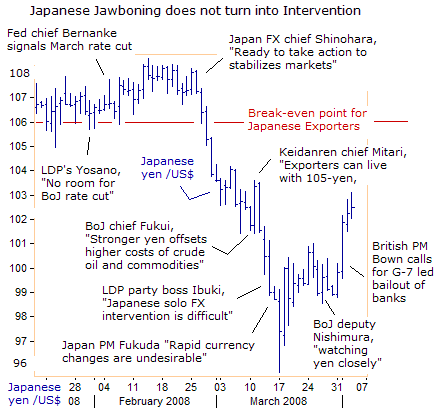
Japan sold a total of 35-trillion yen for $330 billion dollars in the foreign exchange markets during the 15-months to March 2004, trying to defend the dollar between 104-yen and 120-yen. But “with the dollar at 100-yen, unrealized losses on Japan's $1 trillion stash of foreign currencies from its previous interventions, are estimated at 18.5 trillion ($187.2 billion),” admitted Japanese finance chief Fukushiro Nukaga on March 27th. Tokyo also issued short-term financing bills to fund its past intervention efforts, saddling the government with debt that must be paid back.
Signaling a historic shift in Tokyo's foreign exchange policy, former Bank of Japan chief Toshihiko Fukui said on March 7th, “A stronger yen will ease the negative effect from rising costs of crude oil and commodities.” Finance chief Nukaga agrees and told the parliament on March 27th, “If the yen rises, goods will be coming into the country cheaply and could turn the economy for the better while benefiting Japanese consumers. I think it would be good in the medium to long run,” he said.
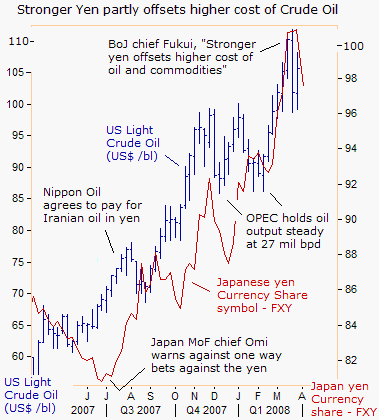
If the crude oil market continues to hover above $100 /barrel, Tokyo might want to see the dollar trade below 104-yen, to keep energy import prices in check. Japanese crude oil imports jumped 41% in January from a year earlier and imports of natural gas rose 30% amid rising commodity prices. Japan's doctored inflation rate hit a decade-high of 1% in February, pushed up by rising oil and food costs.
That means the Bank of Japan's overnight loan rate is a half-percent below the official inflation rate, or at a negative interest rate, and leaves the yen vulnerable to speculative selling pressure by carry traders. If correct, a weaker yen combined with high and rising commodity prices could fuel even faster inflation in Japan. In that case, intensified inflation pressures could eventually persuade the BoJ into hiking its overnight loan rate for the first time since February 2007.
ECB Uses the Euro to Combat Inflation,
Compared to the political lackeys at the Bernanke Fed, the European central bankers are super-hawks, refusing to knuckle under to pressure from union bosses and politicians for rate cuts. “There is no room for complacency and no reason to believe that inflation has been brought under control. The ECB remains firmly focused on price stability,” warned the Bundesbank's Juergen Stark on March 28th.
“Not only are current price pressures alarmingly high but, faced with moderate though basically robust euro zone economic growth, and the continued strong money supply expansion, there are medium-term upside risks to price stability,” said Bundesbank chief Axel Weber. “In this volatile market environment, it is essential to continue to anchor inflation expectations at a low level,” he added.
But for the past several months, ECB official have refused to lift the bank's repo rate above 4%, where it's been stuck for the past 10-months, arguing that a central bank can't produce an extra barrel of crude oil, nor an extra bushel of soybeans, with a tighter monetary policy. But the ECB has vowed to tighten monetary policy, if second round inflation effects, namely wage increases, exceed the general inflation rate.
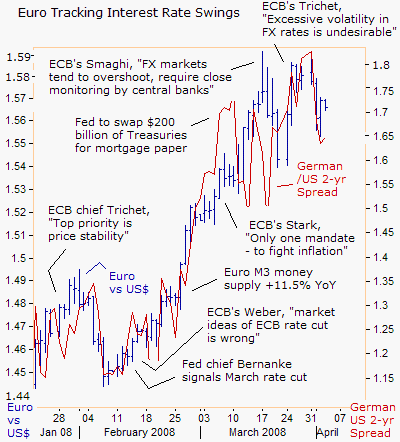
Yet last week, German public sector workers won their biggest pay rise in 16-years, equating to a 5.1% rise for 2008, the biggest pay increase since 1992, Germany's biggest industrial union also delivered a 5.2% pay rise for steel workers, their biggest in 16-years. Boxed into a corner with their own empty rhetoric, ECB officials are balking at lifting the repo rate, to contain the Euro M3 money supply.
Instead, much like the Bank of Japan and the Swiss National Bank, the ECB is utilizing a stronger currency to fend off inflationary pressures from soaring commodity prices. But the rise in the Euro /US$ exchange rate has still lagged behind the increase in food and energy prices. As a result, inflation in the 15 countries using the Euro accelerated to 3.5% in March, a 16-year high, and even further above the ECB's long ignored inflation target of 2 percent.
A stronger Euro is a blunt instrument for the ECB, because a weaker US dollar also exerts upward pressure on crude oil and other international commodities that are imported into the Euro zone. Therefore, although the ECB's repo rate is officially pegged at 4%, the ECB hawks have clandestinely pursued a quasi-tightening of monetary policy, by allowing the 3-month Euro Libor rate to climb to 4.75%, or 40-basis points higher than it usual spread to the repo rate.
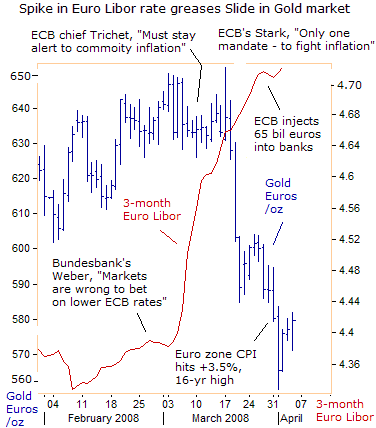
Setting the stage for the latest spike in Euro Libor rates, on Feb 27th, Bundesbank chief Axel Weber signaled his support for lifting rates in Europe. “While recent price shocks have so far had only a small impact on expectations until now, that must remain the case in the future. If we were to see a clear upward trend, that would be for us a clear signal to act with monetary policy,” he warned.
“Market expectations that the European Central Bank will cut interest rates fail to consider the dangers of higher inflation. Be assured, our aim is and remains price stability in the medium term,” Weber added. On March 12th, his sidekick Juergen Stark ruled out an ECB rate cut to cushion battered Euro zone stock markets. “This correction we are experiencing is necessary, it's painful and it's unavoidable. But I would warn against any knee-jerk reaction,” he said.
The upward surge in Euro Libor interest rates to 4.75% might have contributed to the stunning shakeout in the gold market from March 17th thru “April Fools” day. In the background, the New York Fed began shifting its tactics and lifted short-term US Treasury yields. But the gold market in Europe found an interim bottom at 560 euros /oz, after the ECB capped the rise in the Euribor rates at 4.75 percent.
How much longer will Saudi Arabia support the US$?
With oil soaring to a record $112 a barrel, and the Fed working overtime to prevent a meltdown in the global financial system, US President George Bush was looking for a quick fix to stabilize the US stock markets, and sent his trusted deputy Dick Cheney to the Middle East to meet with Saudi King Abdullah, the de-facto leader of OPEC. In advance of Cheney's 4-½ hour meeting at the king's farm on March 22nd, crude oil in New York tumbled by $5 /barrel, briefly slipping below $100 /barrel.
“Obviously, we want to see an increase in oil production,” said White House spokeswoman Dana Perino. “The president wants OPEC to take into consideration that the US economy has weakened, partly because of higher oil prices. We think more supply would help, and I don't anticipate that the vice president would have any other message than that one,” Perino said.
The US “Plunge Protection Team” is struggling to rescue an American economy that is sagging under the weight of sliding home prices, sharply higher food and energy prices, and a banking crisis, and with little luck in persuading Riyadh to increase oil production. Instead, OPEC blames the US Treasury, which has done nothing to prop-up the weak dollar, which boosts US exports but makes oil more expensive
 Two days later, Cheney hinted there was no quick fix from king Abdullah. “We've seen the price of oil rise dramatically to over $100 a barrel. It reflects the realities in the marketplace. There is very little spare capacity in the global oil market, and there is increasing demand for oil in China, India and in the oil producing nations themselves. The price of oil reflects the new realities in the marketplace,” he said.
Two days later, Cheney hinted there was no quick fix from king Abdullah. “We've seen the price of oil rise dramatically to over $100 a barrel. It reflects the realities in the marketplace. There is very little spare capacity in the global oil market, and there is increasing demand for oil in China, India and in the oil producing nations themselves. The price of oil reflects the new realities in the marketplace,” he said.
Cheney's visit to the Persian Gulf monarchs also included a personal plea to avoid pulling the plug on the US dollar's artificial life support. If the Arab oil kingdoms decide to ditch their dollar pegs, to control inflation and diversify their overseas assets to earn higher returns in other currencies or in gold and real estate outside the US, the net result could be the loss of the US dollar's reserve currency status.
But the vice president's itinerary for his nine-day tour of the rgion, Oman, Saudi Arabia, Israel and Turkey, was also designed for saber rattling with Tehran. Cheney's hawkish threats over Iran's nuclear weapons program keeps the Arab oil kingdoms wedded to the dollar, since the US military is the guarantor of the Arabian Gulf's security. But the cost of sticking with the archaic dollar peg is intolerably high, and threatening social unrest in the kingdoms.
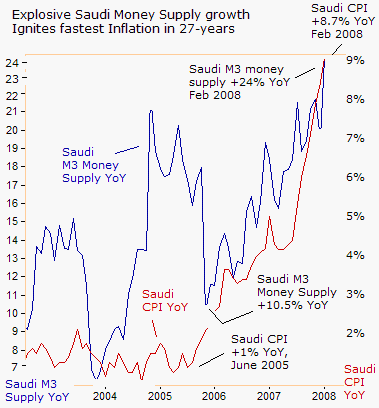
The Bernanke Fed is expanding the US M3 money supply at a 17% annualized rate, the fastest in history, so the Saudi central bank is expanding its M3 money supply at a faster 24% rate, in order to prevent the Saudi riyal from rising against the US dollar. The Saudi central bank matched the Fed's 75 basis point rate cut on March 18th, cutting bank deposit rates to 2.25%, which is far below the inflation rate.
In turn, the explosive money supply growth and negative rates of interest are fanning the flames of inflation in the desert kingdom, hitting 8.7% in February, a 27-year high. The dollar peg is fuelling inflation by making imports from Asia and Europe more expensive as the US currency sinks on global markets. Rents led the rise in Saudi inflation, surging 18%, followed by food costs up 13 percent.
 Saudi Arabia, the United Arab Emirates, Kuwait, Qatar, Oman and Bahrain control 40% of the world's proven crude oil reserves. And the recent commodity price boom has swelled the coffers of governments that control commodity exports or heavily taxes the revenues earned by private commodity exporters. As a result, the assets managed by Persian Gulf sovereign wealth funds (SWF's), have ballooned to roughly $2.5 trillion from $472.5 billion in 2004.
Saudi Arabia, the United Arab Emirates, Kuwait, Qatar, Oman and Bahrain control 40% of the world's proven crude oil reserves. And the recent commodity price boom has swelled the coffers of governments that control commodity exports or heavily taxes the revenues earned by private commodity exporters. As a result, the assets managed by Persian Gulf sovereign wealth funds (SWF's), have ballooned to roughly $2.5 trillion from $472.5 billion in 2004.
Funds derived from oil and gas export revenues account for roughly two-thirds of the total assets held by sovereign wealth funds (SWF's), with the rest controlled by Asian surplus exporters. Saudi Arabia is planning a SWF for $900 billion, and the Abu Dhabi Investment Authority controls $875 billion. The Kuwait Investment Authority oversees $213 billion, and the Qatar Investment Authority had an estimated value of $60 billion at the end of February.
By 2015, the Persian Gulf SWF's could grow to $6-7 trillion. If Chinese, Russian, and Korean SWF's are taken into account, the total global SWF value could top $12 trillion, or nearly the size of the US economy. One has to wonder what direction the Persian Gulf SWF's will take, if the Illinois senator, Barack Obama wins the US presidency in November, and hastily withdraws US troops from Iraq.
By Gary Dorsch,
Editor, Global Money Trends newsletter
http://www.sirchartsalot.com
To stay on top of volatile markets, subscribe to the Global Money Trends newsletter today, for insightful analysis and predictions for the (1) top stock markets around the world, (2) Commodities such as crude oil, copper, gold, silver, and related gold mining and oil company indexes (3) Foreign currencies (4) Libor interest rates, global bond markets and central bank monetary policies, and (5) Central banker "Jawboning" and Intervention techniques that move markets.
GMT filters important news and information into (1) bullet-point, easy to understand analysis, (2) featuring "Inter-Market Technical Analysis" that visually displays the dynamic inter-relationships between foreign currencies, commodities, interest rates and the stock markets from a dozen key countries around the world. Also included are (3) charts of key economic statistics of foreign countries that move markets.
Subscribers can also listen to bi-weekly Audio Broadcasts, with the latest news on global markets, and view our updated model portfolio for Q'1, 2008. To order a subscription to Global Money Trends, click on the hyperlink below,
http://www.sirchartsalot.com/newsletters.php
Mr Dorsch worked on the trading floor of the Chicago Mercantile Exchange for nine years as the chief Financial Futures Analyst for three clearing firms, Oppenheimer Rouse Futures Inc, GH Miller and Company, and a commodity fund at the LNS Financial Group.
As a transactional broker for Charles Schwab's Global Investment Services department, Mr Dorsch handled thousands of customer trades in 45 stock exchanges around the world, including Australia, Canada, Japan, Hong Kong, the Euro zone, London, Toronto, South Africa, Mexico, and New Zealand, and Canadian oil trusts, ADR's and Exchange Traded Funds.
He wrote a weekly newsletter from 2000 thru September 2005 called, "Foreign Currency Trends" for Charles Schwab's Global Investment department, featuring inter-market technical analysis, to understand the dynamic inter-relationships between the foreign exchange, global bond and stock markets, and key industrial commodities.
Copyright © 2005-2008 SirChartsAlot, Inc. All rights reserved.
Disclaimer: SirChartsAlot.com's analysis and insights are based upon data gathered by it from various sources believed to be reliable, complete and accurate. However, no guarantee is made by SirChartsAlot.com as to the reliability, completeness and accuracy of the data so analyzed. SirChartsAlot.com is in the business of gathering information, analyzing it and disseminating the analysis for informational and educational purposes only. SirChartsAlot.com attempts to analyze trends, not make recommendations. All statements and expressions are the opinion of SirChartsAlot.com and are not meant to be investment advice or solicitation or recommendation to establish market positions. Our opinions are subject to change without notice. SirChartsAlot.com strongly advises readers to conduct thorough research relevant to decisions and verify facts from various independent sources.
Gary Dorsch Archive |
© 2005-2022 http://www.MarketOracle.co.uk - The Market Oracle is a FREE Daily Financial Markets Analysis & Forecasting online publication.


